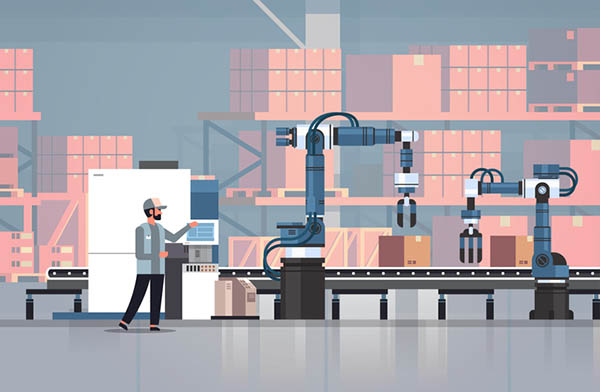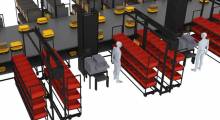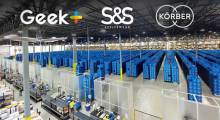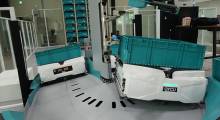The 2020s have ushered in a series of headaches for warehousing and supply chain managers. Two of them are supply shortages and a tight labor market with growing wages. Though automation can't solve material shortages, the industry's latest generation of robotic goods-to-person systems and advances in mobile robots can significantly reduce distribution centers' dependency on manual labor.
Warehouses are increasingly investing in technologies that can store, retrieve, and increase order-picking speeds to offset labor costs. Not only can this investment reduce costs and increase efficiency, but it can also enable better utilization of facility space.
Goods-to-person (G2P) functionality can rapidly expand to meet these needs, making warehouse robots more cost-effective. As a result, G2P systems and autonomous mobile robots (AMRs) are the fastest-growing product segments in the material handling automation space. AMRs outsold automated guided vehicles (AGVs) for the first time in 2021.
Reconsider robotics with integrator aid
If you have not considered robotics because of its perceived cost or applicability to your operation, it's time to reassess your decision. Today's AMRs, especially for G2P automation, can have a rapid return on investment (ROI), even for small and medium-size warehouses, especially in a tight labor market.
There are abundant G2P solutions that combine software with a range of warehouse robots. However, that's a lot to sort through. So, to put all these pieces together, you should consider the guidance of an experienced warehouse systems integrator.
Such experts have experience across many industries and warehouse operations, and they can recommend and provide the most suitable AMRs and G2P systems for a particular job. An integrator can draw from past experience, evaluate a wide range of technologies, and choose the best match for an operation's needs from a worldwide network of vendors.
Map out your warehouse automation investment
Before adopting warehouse automation, create a roadmap to define the necessary process improvements, and then you can implement the right blend of hardware and software. Any investment, especially in AMRs or a robotic G2P order-picking system, requires a thorough analysis of current yearly order volume, peak season volume, and the projected five-year business growth.
The order profile, SKU count, cube weight, and velocity movement data will determine which types of warehouse automation you need and the right blend of technologies. These choices range from pick-to-light, voice picking, and automated conveyor systems to AMR-based batch cart order picking, G2P robots, and packing and shipping automation, including printing and applying labels.
All of these technologies have a role to play in distribution centers and warehouses. An independent integrator can help an operator achieve the highest efficiency gain with a design matched to the business' ROI goal.
Manage workflows with software
The next critical task is defining duties and selecting the right warehouse execution and control system (WES-WCS). Such a software platform has modules that manage, control, and unite all the automation with the enterprise resource planning (ERP) and warehouse management system (WMS).
The WES-WCS plays crucial roles, from optimizing order releases to orchestrating the AMR fleet manager and G2P control software. In addition, the system provides the data to manage the robots for cart and pallet pickup, transport, and movement to picking locations.
Several WES-WCS systems can coordinate operator picking activities, a duty well-suited to voice picking. Meanwhile, managing AMRs and people within the order-picking process is within the domain of a top-tier WES-WCS system.
In addition, the WES-WCS manages warehouse automation including conveyors, sortation, and pick modules. The goal is to increase productivity and to maintain and synchronize order flow throughout the multiple zones in the facility.
The latest generation of AMRs and G2P systems can reduce reliance on scarce labor and provide faster storage, picking, moving, and sorting. Warehouse operators have more options than ever to consider for materials handing automation that can have a significant impact on their business.
Partnering with an experienced, independent systems integrator from the initial design phase through the implementation phase should lower risk and ensure the project's success. In addition, optimizing your warehouse operation can maximize the benefits of automation matched to today's and future business growth.
About the author

Dan Hanrahan is the founder and president of Numina Group. He and his software and engineering team have more than 35 years of experience with material handling, software, control, and process improvement. The team focuses on streamlining and improving productivity in existing and new warehouse operations with automation.
The Numina Group is a systems integration firm focused on defining leaner and more productive processes, managed with leading warehouse automation software. The Woodridge, Ill.-based company's Real-Time Distribution Software (RDS) platform is a modular warehouse control and execution system (WCS-WES).
RDS includes a full suite of pre-developed order-fulfillment pick, pack, and ship automation modules. They include pick by voice, pick to light, and pre-developed application programming interfaces (APIs) for integrating G2P and AMR systems. These supply chain technologies are proven to lower labor costs and to optimize distribution operations.
Article topics
Email Sign Up
















